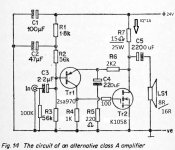Class A means that the output device, whatever kind it may be, is running constant current all the time.
Can you give an example for an amp where the active device is running at constant current?
What is this amplifier?
Is it Single End or Push Pull?
It is obviously PP, a strange question coming from you. Another way to create a PP amp is to bridge two SE amps.
This is simple Single-End A-class amp under my development , very similar two stage A-class amp is already done by one famous Russian designer , it is energy very inefficient but with his HQ sonics outperforms some high quality 3W 2A3 SET tube amp.
Attachments
PP amplifiers usually cancel even harmonics near the idle point, which I hypothesize could be a bad thing: if the sine wave that they are associated with is actually riding along with other signals, creating voltage offsets, then the amplitude of the harmonics will be modulated by those other signals.
SE amplifiers by nature should be much more steady in that sense, because the level of modulation would tend to be masked (swamped) by a higher baseline of even harmonics without sidebands. In other words, those even harmonics never fall to absolute zero and never flip polarity.
Of course, as others have mentioned, both types could be optimised.
SE amplifiers by nature should be much more steady in that sense, because the level of modulation would tend to be masked (swamped) by a higher baseline of even harmonics without sidebands. In other words, those even harmonics never fall to absolute zero and never flip polarity.
Of course, as others have mentioned, both types could be optimised.
It is almost inevitable to have a lot of 2nd harmonics due to nature of single ended tubes amps
There is close to 25% power loses in the magnetic core gap as other effect, not sure, stray inductance, with bigger tube it reduces 2nd harmonics but it increase noise due to electron flow, the same effect can be heard in transistors amps pushing high biases, it somewhat has a warmer sound with less micro details.
Even due to all this s.e.t. might just be the most consistent sound, with the most natural transitions and the best sound...
For details, accuracy and ability to resolve complex music the push pull tube amps and even more single rail transistor amps can be more adequate.
There is close to 25% power loses in the magnetic core gap as other effect, not sure, stray inductance, with bigger tube it reduces 2nd harmonics but it increase noise due to electron flow, the same effect can be heard in transistors amps pushing high biases, it somewhat has a warmer sound with less micro details.
Even due to all this s.e.t. might just be the most consistent sound, with the most natural transitions and the best sound...
For details, accuracy and ability to resolve complex music the push pull tube amps and even more single rail transistor amps can be more adequate.
